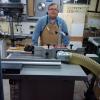I'm thinking of trying my hand at making a rocking chair. I figure the first few will be out of red maple (throw away wood around here) and could end up in the fireplace until I get a design I like and all the angles correct. One thing I keep coming back to is making a pattern jig/ sled for my shaper and using a byrd head (or similar) with a rub collar to make the runners. I've only used my shaper with the fence installed so I figured I would ask for advice before launching wood in a dangerous direction. I have read some here about it but I was hoping someone might have a link to a video as well.
My shaper is a 3hp (the motor has to be the strongest 3hp I've ever seen, a US Motors brand made in the US) that turns at just under 8000 rpm no load. I'm thinking that the best thing to do would be to draw a line on the wood and trim it on the band saw within a 1/16th of an inch to reduce how much I would need to remove. So my first question would be which diameter cutter? I read that a 3" diameter head may be too slow and be more likely to cause a kickback. I can easily put a 4" long head with a rub collar on my shaper so I figured there was little reason not to buy one that long. My 8" jointer only has a 1 1/2 hp motor so I think I'll be fine power wise as long as I don't take too much off in one bite. The next question is how to secure the wood to the pattern securely. Would toggle clamps be the best way (this is how I was thinking)? Double sided wood tape? Something else?
I'm hoping to start making some parts later this summer so I can get a feel for the process and then next winter actually try to come up with a design I like.




 Reply With Quote
Reply With Quote


